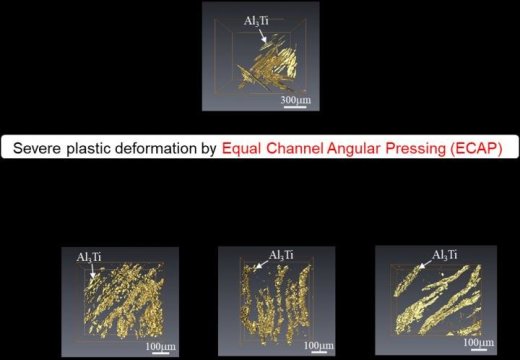[ad_1]
From the pots and pans on the stove to the wires suspending bridges, metal composites need to account for a variety of strength, malleability, and durability to meet human need. Now, researchers from the Nagoya Institute of Technology (NITech) in Japan have applied three-dimensional crystallography to visualize how individual particles shape up the composites — and how they might be manipulated to make better versions of themselves
“Strength of the composite is controlled by size, spatial distribution, and three-dimensional shape of the particles,” said Dr. Hisashi Sato, an associate professor in the Graduate School of Engineering and in the Frontier Research Institute for Materials Science. He collaborated on this research with Prof. Yoshimi Watanabe.
In making the composites, such as drawing out metal alloys to make suspension wire for bridges, the materials are pressed and stressed to break apart the particles. The particles are then drawn out into a thinner rearrangement, but they must be carefully controlled to avoid losing strength or becoming brittle. This process, called Equal Channel Angular Pressing (ECAP), is referred to as “deforming” the particles of the composite from their original state.
According to Dr. Sato, no one had examined the particle distribution change by images in the deformed composite in three dimensions. Dr. Sato and Prof. Watanabe used 3D microstructural observation and crystallographic analysis to investigate how the particles changed in shape, size, and placement in aluminum-based composites.
They found that the deformed fragments re-distributed on how the scaffolding — the matrix — underlying the composite was broken apart and put back together, such as particles rearranging closer together as suspension wire is drawn out because the surface area is reduced. More than that, Dr. Sato said that the particle distribution in the deformed composite could actually be controlled based on material flow of its matrix.
The researchers also investigated the effects of shearing patterns, or changing the direction of the specimen for each ECAP pass. In attached figure, Route A is the case of specimen with no rotation, and Route Bc is the case of 90-degree rotation, and Route C is the case of 180-degree rotation with 4 passes. They found Route Bc produces the smallest Al-Al3Ti particle fragment.It is considered that the Al3Ti intermetallic particle preferentially fragments at a specific location in the deformation process, which offers another level of control to create better grain.
Previously, according to Dr. Sato, researchers saw that the deformation process for the Al-Al3Ti composite created better grain refiner for the Al casting, but they didn’t understand the mechanisms underlying the improved outcomes. Now, researchers and engineers may be able to design better grain refiner for Al casting with precise control.
“Strength and ductility of the metal-based composite strongly depend on the particle size and the spatial distribution of the particle,” Dr. Sato said. “Understanding the relationship between the particle size, the particle spatial distribution, and the mechanical properties of the composite is important in order to design the composite with higher strength and ductility.”
Story Source:
Materials provided by Nagoya Institute of Technology. Note: Content may be edited for style and length.
[ad_2]















